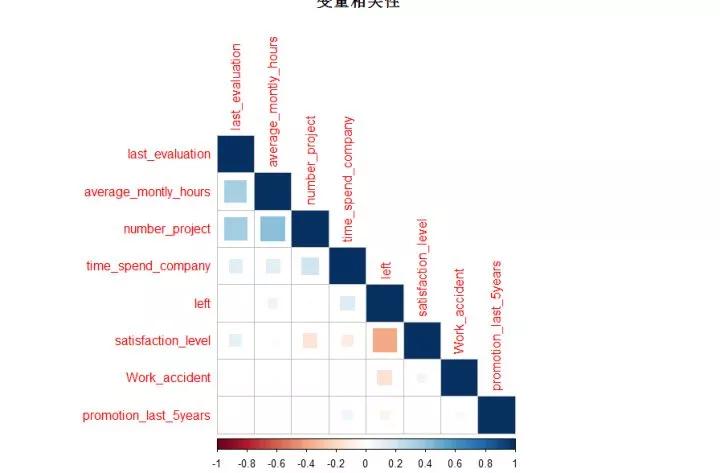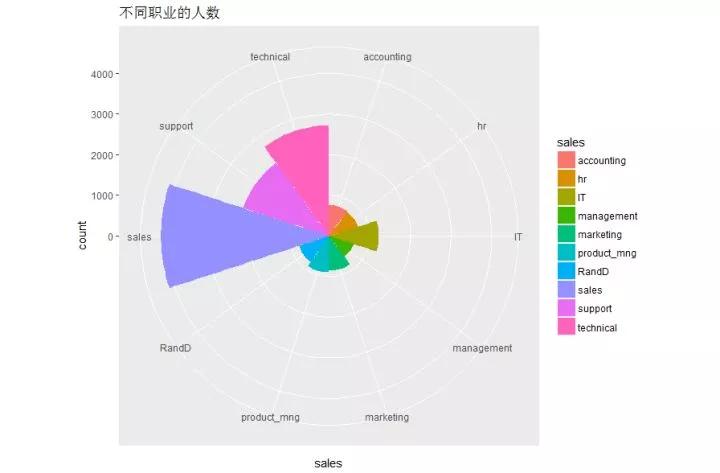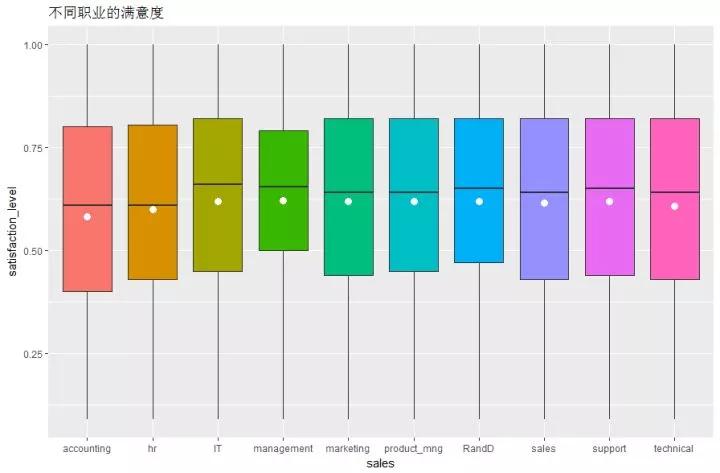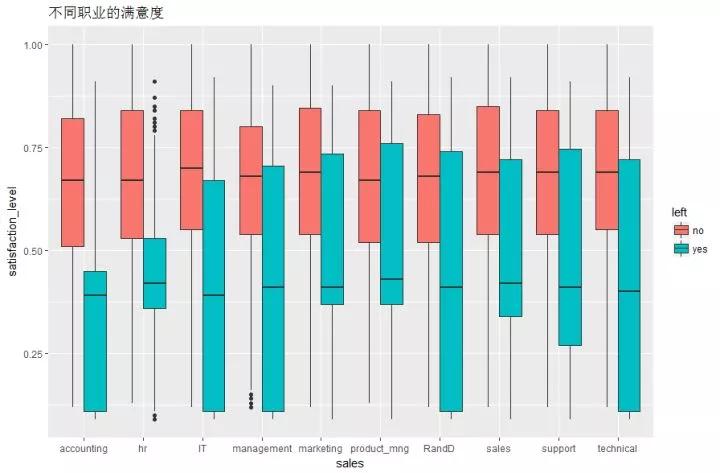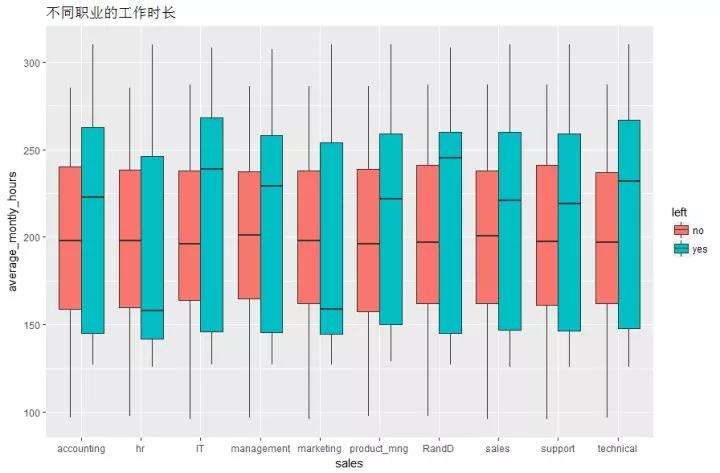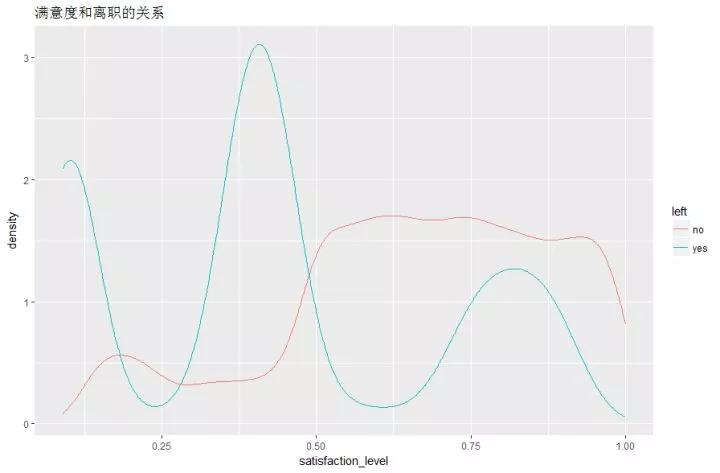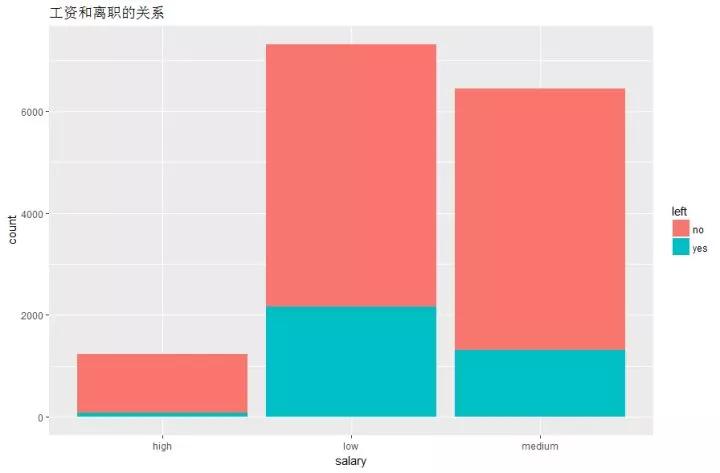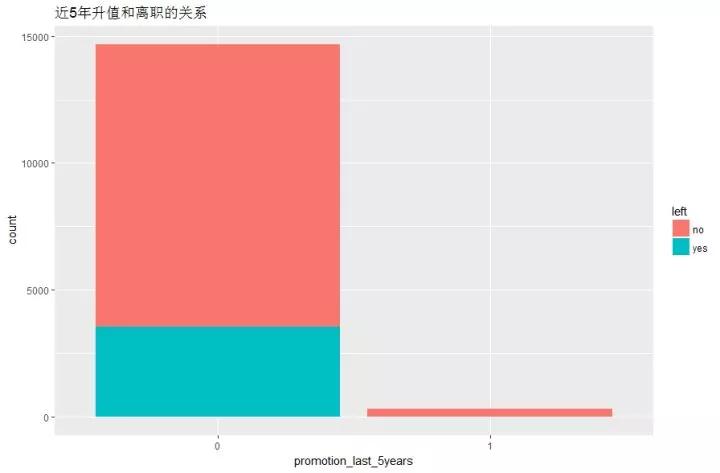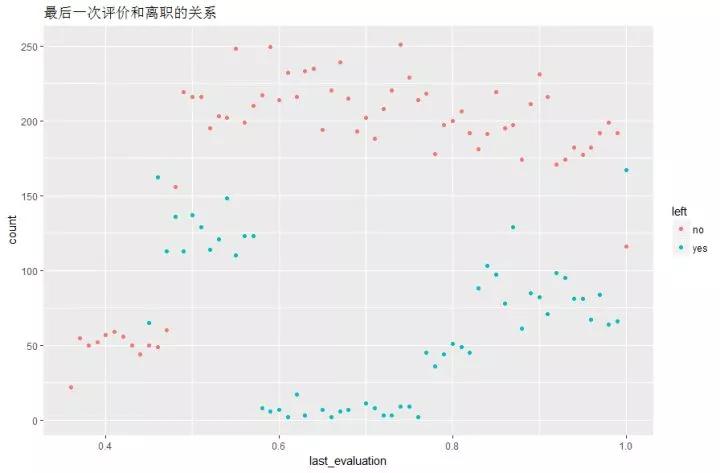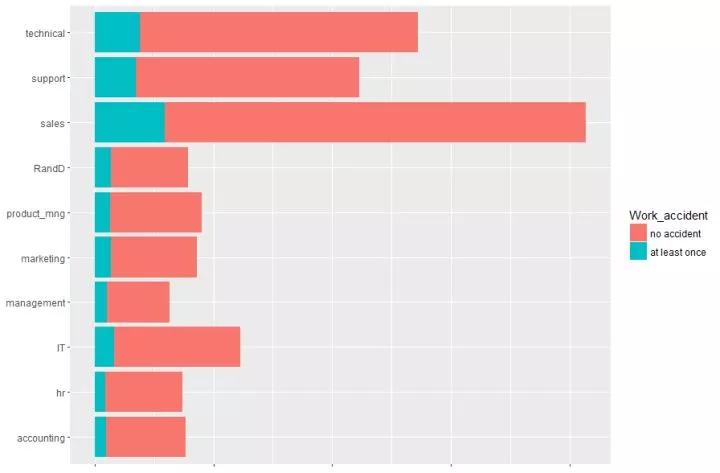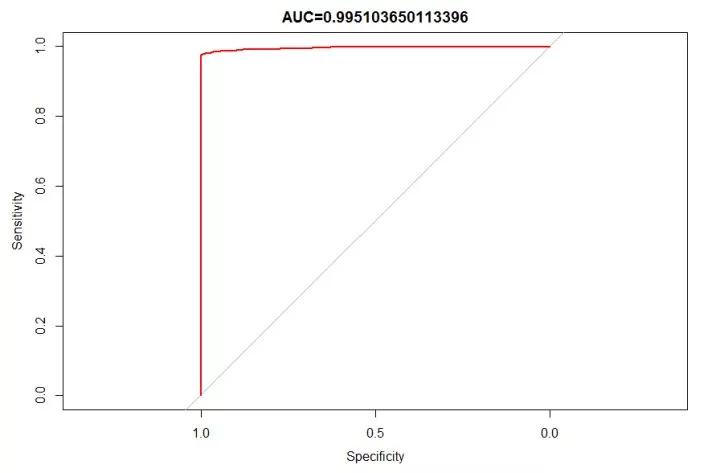在实验室搬砖之后,继续我们的kaggle数据分析之旅,这次数据也是答主在kaggle上选择的比较火的一份关于人力资源的数据集,关注点在于员工离职的分析和预测,依然还是从数据读取,数据预处理,EDA和机器学习建模这几个部分开始进行,***使用集成学习中比较火的random forest算法来预测离职情况。
数据读取
- setwd("E:/kaggle/human resource")
- library(data.table)
- library(plotly)
- library(corrplot)
- library(randomForest)
- library(pROC)
- library(tidyverse)
- library(caret)
- hr<-as.tibble(fread("HR_comma_sep.csv"))
- glimpse(hr)
- sapply(hr,function(x){sum(is.na(x))})
- ————————————————————————————————————————————————————————————————————————————————————
- Observations: 14,999
- Variables: 10
- $ satisfaction_level <dbl> 0.38, 0.80, 0.11, 0.72, 0.37, 0.41, 0.10, 0.92, 0.89, 0.42, 0.45, 0.11, 0.84, 0.41, 0.36, 0.38, 0.45, 0.78, 0.45, 0.76, 0.11, 0.3...
- $ last_evaluation <dbl> 0.53, 0.86, 0.88, 0.87, 0.52, 0.50, 0.77, 0.85, 1.00, 0.53, 0.54, 0.81, 0.92, 0.55, 0.56, 0.54, 0.47, 0.99, 0.51, 0.89, 0.83, 0.5...
- $ number_project <int> 2, 5, 7, 5, 2, 2, 6, 5, 5, 2, 2, 6, 4, 2, 2, 2, 2, 4, 2, 5, 6, 2, 6, 2, 2, 5, 4, 2, 2, 2, 6, 2, 2, 2, 4, 6, 2, 2, 6, 2, 5, 2, 2, ...
- $ average_montly_hours <int> 157, 262, 272, 223, 159, 153, 247, 259, 224, 142, 135, 305, 234, 148, 137, 143, 160, 255, 160, 262, 282, 147, 304, 139, 158, 242,...
- $ time_spend_company <int> 3, 6, 4, 5, 3, 3, 4, 5, 5, 3, 3, 4, 5, 3, 3, 3, 3, 6, 3, 5, 4, 3, 4, 3, 3, 5, 5, 3, 3, 3, 4, 3, 3, 3, 6, 4, 3, 3, 4, 3, 5, 3, 3, ...
- $ Work_accident <int> 0, 0, 0, 0, 0, 0, 0, 0, 0, 0, 0, 0, 0, 0, 0, 0, 0, 0, 1, 0, 0, 0, 0, 0, 0, 0, 0, 0, 0, 0, 0, 0, 0, 0, 0, 0, 0, 0, 0, 0, 0, 0, 0, ...
- $ left <int> 1, 1, 1, 1, 1, 1, 1, 1, 1, 1, 1, 1, 1, 1, 1, 1, 1, 1, 1, 1, 1, 1, 1, 1, 1, 1, 1, 1, 1, 1, 1, 1, 1, 1, 1, 1, 1, 1, 1, 1, 1, 1, 1, ...
- $ promotion_last_5years <int> 0, 0, 0, 0, 0, 0, 0, 0, 0, 0, 0, 0, 0, 0, 0, 0, 0, 0, 1, 0, 0, 0, 0, 0, 0, 0, 0, 0, 0, 0, 0, 0, 0, 0, 0, 0, 0, 0, 0, 0, 0, 0, 0, ...
- $ sales <chr> "sales", "sales", "sales", "sales", "sales", "sales", "sales", "sales", "sales", "sales", "sales", "sales", "sales", "sales", "sa...
- $ salary <chr> "low", "medium", "medium", "low", "low", "low", "low", "low", "low", "low", "low", "low", "low", "low", "low", "low", "low", "low...
- satisfaction_level last_evaluation number_project average_montly_hours time_spend_company Work_accident left
- 0 0 0 0 0 0 0
- promotion_last_5years sales salary
- 0 0 0
数据集情况如下,一共10维数据,14999个观测值,变量的代表名称分别是
satisfaction_level--满意度,last_evaluation--***一次评估,number_project--参与项目数量,average_montly_hours--每月平均工作时间,time_spend_company--公司停留时间,Work_accident--工作事故次数,left--是否离职,promotion_last_5years--过去五年升值状况,sales--工种,salary--工资。
而且简单的观测了一下,没有发现缺失值,那么我就可以直接进入数据分析阶段了。
数据预处理
根据每一个特征的数值情况,我们可以将不少特征因子化,方便后期做不同类别的差异分析。
- hr$sales<-as.factor(hr$sales)
- hr$salary<-as.factor(hr$salary)
- hr$left<-as.factor(hr$left)
- hr$Work_accident<-as.factor(hr$Work_accident)
- hr$left<-recode(hr$left,'1'="yes",'0'="no")
- hr$promotion_last_5years<-as.factor(hr$promotion_last_5years)
看的出大部分数据都是数值型的,我们使用相关性来衡量不同变量之间的相关性高低:
- cor.hr<-hr %>% select(-sales,-salary)
- cor.hr$Work_accident<-as.numeric(as.character(cor.hr$Work_accident))
- cor.hr$promotion_last_5years<-as.numeric(as.character(cor.hr$promotion_last_5years))
- cor.hr$left<-as.numeric(as.character(cor.hr$left))
- corrplot(corr = cor(cor.hr),type = "lower",method = "square",title="变量相关性",order="AOE")
直观的来看,是否离职和满意度高低就有很高的关联性啊。
EDA
- ggplot(group_by(hr,sales),aes(x=sales,fill=sales))+geom_bar(width = 1)+coord_polar(theta = "x")+ggtitle("不同职业的人数")
- ggplot(hr,aes(x=sales,y=satisfaction_level,fill=sales))+geom_boxplot()+ggtitle("不同职业的满意度")+stat_summary(fun.y = mean,size=3,color='white',geom = "point")+
- theme(legend.position = "none")
- ggplot(hr,aes(x=sales,y=satisfaction_level,fill=left))+geom_boxplot()+ggtitle("不同职业的满意度")
- ggplot(hr,aes(x=sales,y=average_montly_hours,fill=left))+geom_boxplot()+ggtitle("不同职业的工作时长")
- ggplot(hr,aes(x=sales,y=number_project,fill=left))+geom_boxplot()+ggtitle("不同职业的项目情况")
首先观察不同岗位的工作人数。搞销售的人数真的是不少,难道有不少我大生科的同学吗??(哈哈哈哈哈哈哈,开个玩笑而已,不过说实话做生物真的很累啊)。销售,后期支持,和技术岗人数占据人数排行榜前三。
不同的职业满意度的分布大体相当,不过accounting的小伙伴们似乎打分都不高哦,其他的几个工种均值和中位数都没有明显差别,接下来我们看看不同职业是否离职的情况和打分的高低情况:
和想象中结果几乎没有区别,离职和不离职的打分区分度很高,和职业几乎没有关系。
那么不同职业的平均工作时长呢,看图而言,没有离职的人群工作时间都很稳定,但是离职人群的工作时间呈现两极分化的趋势,看来太忙和太闲都不是很好,这对hr的考验还是很大的。
后面我们来一次关注一下不同特征和离职的关系问题:
- ggplot(hr,aes(x=satisfaction_level,color=left))+geom_line(stat = "density")+ggtitle("满意度和离职的关系")
- ggplot(hr,aes(x=salary,fill=left))+geom_histogram(stat="count")+ggtitle("工资和离职的关系")
- ggplot(hr,aes(x=promotion_last_5years,fill=left))+geom_histogram(stat="count")+ggtitle("近5年升值和离职的关系")
- ggplot(hr,aes(x=last_evaluation,color=left))+geom_point(stat = "count")+ggtitle("***一次评价和离职的关系")
- hr %>% group_by(sales) %>% ggplot(aes(x=sales,fill=Work_accident))+geom_bar()+coord_flip()+
- theme(axis.text.x = element_blank(),axis.title.x = element_blank(),axis.title.y = element_blank())+scale_fill_discrete(labels=c("no accident","at least once"))
没有离职的人群打分已知非常稳定,而离职人群的打分就有点难以估摸了
还是那句话,“有钱好办事啊”
你不给宝宝升职,宝宝就生气离职
和前面的面积图差不多,hr也要警惕那些***一次打分很高的,虽然大部分是不准备离职的,但是有些为了给老东家面子还是会来点“善意的谎言”的。
不出错是不可能的,出错人数多少基本和总人数成正比,所以这个对于离职来说不是问题。
模型构建和评估
- index<-sample(2,nrow(hr),replace = T,prob = c(0.7,0.3))
- train<-hr[index==1,];test<-hr[index==2,]
- model<-randomForest(left~.,data = train)
- predict.hr<-predict(model,test)
- confusionMatrix(test$left,predict.hr)
- prob.hr<-predict(model,test,type="prob")
- roc.hr<-roc(test$left,prob.hr[,2],levels=levels(test$left))
- plot(roc.hr,type="S",col="red",main = paste("AUC=",roc.hr$auc,sep = ""))
根据前面的特征分析,本次答主并没有觉得有很好的特征来提取,就直接扔进算法里面计算去了,计算出来的混淆矩阵的情况效果还是杠杠的:
- Confusion Matrix and Statistics
- Reference
- Prediction no yes
- no 3429 5
- yes 28 1010
- Accuracy : 0.9926
- 95% CI : (0.9897, 0.9949)
- No Information Rate : 0.773
- P-Value [Acc > NIR] : < 2.2e-16
- Kappa : 0.9791
- Mcnemar's Test P-Value : 0.0001283
- Sensitivity : 0.9919
- Specificity : 0.9951
- Pos Pred Value : 0.9985
- Neg Pred Value : 0.9730
- Prevalence : 0.7730
- Detection Rate : 0.7668
- Detection Prevalence : 0.7679
- Balanced Accuracy : 0.9935
- 'Positive' Class : no
acc=0.9926,recall=0.9951,precision=0.9730,基本都是逆天的数据了,看来kaggle的数据集已经清洗的很棒了,rf算法也是一如既往地给力。***贴出ROC曲线的图
写在***
本次分析其实并没有很多的技巧可言,答主的ggplot2水平也遇到了瓶颈期,后期需要不断加强,而且只会调包不懂算法后面的原理更是不可以的,所以最近在慢慢把概率论,线性代数,还是统计学捡起来,当然R语言的数据分析实践还是不会停下来的,答主英语还不错,可以和实验室的老外教授“忽悠”几句,也算是有了不少的进步。
道阻且长,大家共勉~~~














